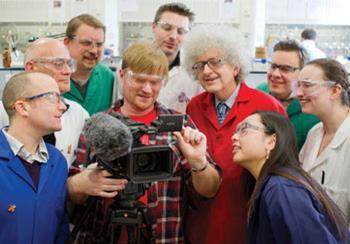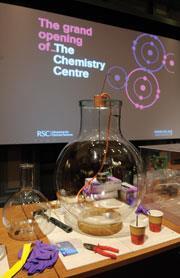The explosion is the doyenne of chemical demonstrations, but is the web taking over as a tool for researchers to enthuse the public about chemistry? Phillip Broadwith investigates
The explosion is the doyenne of chemical demonstrations, but is the web taking over as a tool for researchers to enthuse the public about chemistry? Phillip Broadwith investigates
Bang! A hydrogen-oxygen balloon explodes. Flash! Woof! The eerie blue chemiluminescence of the ’barking dog’ reaction careens down an oversize glass tube. These are the familiar sights and sounds of the classic chemistry demonstration. The excitement of explosions and seeing chemical reactions happening in front of our eyes has encouraged countless generations of enquiring minds to focus their attention on chemistry. During this International Year of Chemistry, with its stated goal of increasing public appreciation of chemistry in meeting world needs, encouraging interest in chemistry among young people, and generating enthusiasm for the creative future of chemistry, there have doubtless been even more of these demonstrations around the world. But is this still the best way to reach out to the public? A lecture hall can only hold a finite number of people, whereas the internet offers the potential to reach audiences of millions.

’People are always going to be interested in the flash-bang shows,’ says Samantha Tang from the University of Nottingham, UK. ’Our demonstration lectures are always oversubscribed. Doing things online has the advantage that people can access it on demand from all over the world, but it’s not the same as actually seeing and smelling it live. It’s a bit like music - people buy albums and watch bands online, but they still go to concerts.’
And she should know. As part of her role as public awareness scientist in Nottingham’s school of chemistry, Tang is involved with the Periodic Table of Videos - a collaboration between active researchers and professional film maker Brady Haran. The series of short videos about the elements, now extending to molecules, has become a YouTube sensation, with hundreds of thousands of views.

Tang explains that the key to its success is the combination of enthusiastic academic participation and Haran’s expertise and detachment from the science. ’If we’d made the videos ourselves, they would never have been so successful,’ she says. ’They have to look slick and professional or people just switch off.’ And it’s not just about holding the camera steady and editing the footage smoothly. ’Brady’s interested in science but isn’t a scientist himself,’ she adds, ’so he can cut out the jargon and ask the important questions.’
Playing to your strengths
This kind of partnership between researchers and third parties is something that can take activities to a different level, says Clare Matterson, director of medical humanities and engagement at the UK’s Wellcome Trust, which devotes a significant share of its funding to public engagement projects.
’We have found that some of our most successful grants are when researchers work with others, and it’s actually others - be that an artist, a broadcaster or an IT company for example - taking the lead, with the scientists providing advice and input on the scientific content.’ She adds that scientists often want to be able to get on with their science; they don’t want to spend all their time on the day to day management of the project.
Nicola Buckley, head of public engagement at the University of Cambridge, UK, and organiser of the annual Cambridge science festival, agrees that this kind of support is particularly useful. This year the festival attracted around 35 000 visitors to 170 events over two weeks. Buckley explains that the university gets input from a body of enthusiastic academics and students with plenty of engaging ideas, but has also invested in professional expertise in terms of marketing and event organisation.
’The special feature of science festivals is that they are heavily staffed by scientists - there aren’t many other occasions when the public can come face to face with researchers,’ she says, which is something that visitors to the festival really value. By removing the burden of organisation it leaves the scientists free to participate in the festival without being put off by coordinating it.
Finding an audience

No matter what kind of public engagement activity you’re doing, it takes a reasonable amount of effort to prepare and put together, and the physical audience is limited both geographically and temporally - there are only a finite number of people who will be able to experience it first-hand. But there are no such barriers online, as Chris Smith from the Naked Scientists quickly realised in 2001 after a year of running a weekly science show on local radio. ’It quickly became apparent that we were spending the week preparing content for a show that maybe 5000 listeners would hear, but perhaps five million would like to hear,’ he says. This was the birth of the Naked Scientists website. ’The point was to put a radio show on the internet, and in the process it became one of the first podcasts, let alone the first scientific podcast, and we had people downloading it from all over the world.’
Smith, who splits his time between being a clinical lecturer in virology at the University of Cambridge, UK; running and consulting for Naked Scientists radio and live shows in the UK, Australia and South Africa; writing popular science books; and hosting the Chemistry World monthly podcast, explains that a real turning point for the website was when, in 2005, Apple’s iTunes music store entered the podcast market. ’Before we’d been relying on people coming to our site to download the shows,’ he says. When iTunes opened its podcast section, there wasn’t much competition, and early adopters quickly attracted large audiences. This ’iTunes effect’ saw a huge jump in downloads of Naked Scientists podcasts. ’We started having the same amount of traffic per day that we had for a whole month before; our web server literally exploded!’ says Smith.

And this is not only the case for podcasts. ’The web is in the process of reinventing itself,’ explains Smith. ’The mentality has changed 180? in the last couple of years. Rather than expecting everyone to come and visit your website, you make high quality content and then use whatever channels are available to get it in front of an audience.’ While it may sound counterintuitive to give away content on sites like YouTube, iTunes and social media networks, Smith points out that the increase in audience is massive because of their interconnected nature and the tendency of good material to ’go viral’ as it is passed around the networks.
Tang agrees that using YouTube brings massive advantages for the Periodic Table of Videos. ’By using YouTube it’s guaranteed to be free and accessible, and anyone can leave their comments.’ This enables the researchers and producers of the videos to interact with the audience, and also acts as a discussion forum for viewers to interact with each other. ’Sometimes the debates get quite heated on there,’ adds Tang, ’and they’re all talking about science. For us, that’s absolutely brilliant.’
Content is king
So once you’ve found an audience, how do you get them to keep coming back for more? The message is clear - quality is all important. But as the Naked Scientists have discovered, dumbing down is not. ’If you look at what people tell you about media, they say that you’ve got to make it really simple and strip out all the facts, or people won’t understand and won’t listen to it,’ says Smith. ’But actually we’ve found that’s totally the wrong thing. What you need to do is describe the methods really carefully and simplify the language. People can understand anything if you explain it to them clearly, so we keep as many of the facts in as possible but make sure we don’t bamboozle people with jargon.’
For Matterson there’s also a big question mark over the level of support being given to researchers doing controversial or highly contested science who want to engage with the public. ’It’s not as straightforward as just rocking up and opening out big ethical issues or moral debates,’ she points out, raising the example of climate scientists feeling ’battered’ in the wake of the recent ’Climategate’ allegations at the UK’s University of East Anglia (see Chemistry World, January 2010, p10).
The internet becomes a particularly tricky avenue for engagement when there are contested scientific issues involved, she adds. ’On the whole, the internet is a fantastic thing for opening up science, scientists and ideas. But it can also be easily abused, and that’s something that institutions need to think about very seriously.’
This kind of extreme reaction can engender a view that scientists are distrusted by the public. But as Neville Reed, managing director for science, education and industry at the RSC points out, when public attitudes to science are surveyed, the majority responds favourably to some degree. ’But if you ask scientists what they think the public thinks of them,’ he adds, ’they will often say that the public doesn’t like them. So there’s a mismatch, and that confusion comes from the fact that the public doesn’t necessarily understand what researchers do - but that doesn’t necessarily translate into a dislike for the subject.’
Hitting the right target

Reed stresses that engaging with the public, whether on an educational level or through wider campaigns, is and will continue to be a central part of the RSC’s activity. The opening of the Chemistry Centre at Burlington House in London in 2009 has provided a hub for people to come and find out about chemistry, but also a platform for researchers and organisations to reach out to the public more generally, whether physically or on the web. Activities include a programme of public lectures (webcast live on the Reaction website), lunch events and Caf? RSC. ’For the RSC, going forward, we will be investing heavily in online delivery of activities, knowledge and information in a format suitable for the public,’ he says. ’We will also be looking for strategic partnerships, both with other organisations and at a more local level, to deliver specific activities.’ He adds that the RSC is moving towards a more targeted approach, with activities focused where they can have the biggest impact. ’The days of the scattergun approach, such as just sending out posters to all the schools in the country, are numbered.’
The need to target activities towards particular goals is something that Matterson echoes. ’At the moment, there’s a lot of good stuff going on, but there aren’t a lot of institutions that are very clear on what their overall strategy is, other than to "do public engagement".’ Matterson says institutions need to decide on the aims and scope of their activities - who and what they are targeting in terms of audience or opening up debate on particular issues. ’We’ve got to the stage where engagement is recognised as important, but it’s not very strategic yet.’
The UK research councils are also taking steps to try and encourage a more directed approach to engagement activities that they fund. RCUK, the umbrella body for all the councils, has recently announced that it is changing the way it funds public engagement activities. Rather than applying for funding for specific engagement projects from dedicated funding streams held by individual councils - such as the now defunct partnerships for public engagement - researchers are being encouraged to embed ideas into their research grants as part of the pathways to impact scheme. ’We’re moving towards a more embedded model for public engagement. We don’t want it to be an add-on, it should be something that’s integral to research,’ says Kate Miller, public engagement manager at the Engineering and Physical Sciences Research Council (EPSRC).
The funding and resources available for this kind of activity will depend on the size and duration of the research grant, but Miller points out that there is no established upper limit to the funding available, and nothing to stop researchers partnering with communication professionals, as long as the activities are somehow related to the research being done in the grant. But that doesn’t necessarily mean that there isn’t a certain amount of flexibility. ’Research projects are necessarily very specific, and we wouldn’t expect the public engagement activities to be quite that specific, but certainly about their particular area and bringing in their own research.’
However, there is a worry that adding too many constraints to engagement activities runs the risk of stifling individuals’ flair and enthusiasm, so the balance is delicate. ’There’s a danger of moving to more of a tick-box culture, where engagement becomes something researchers have to do rather than being voluntary,’ says Cambridge’s Buckley. ’That would be quite alarming.’






No comments yet